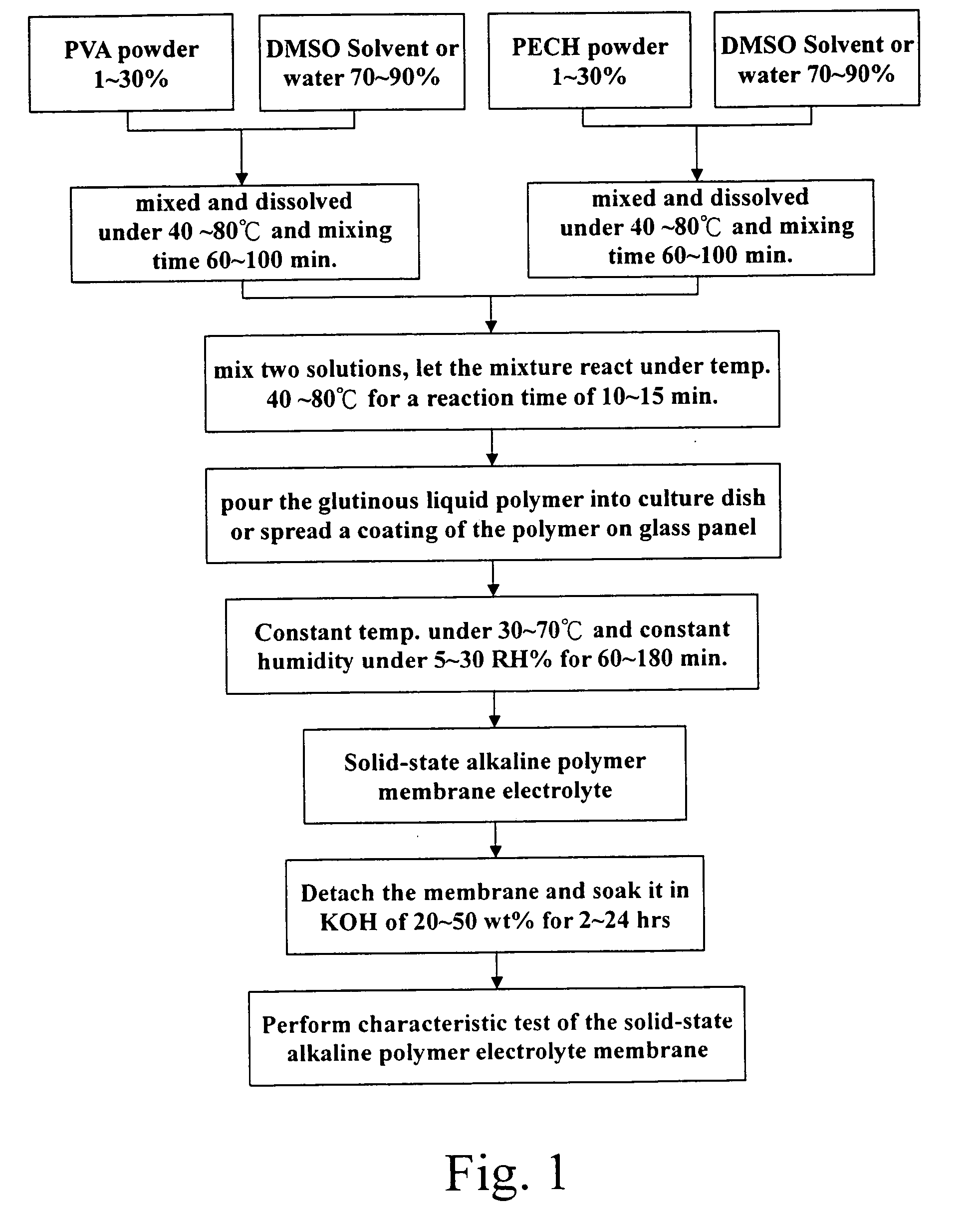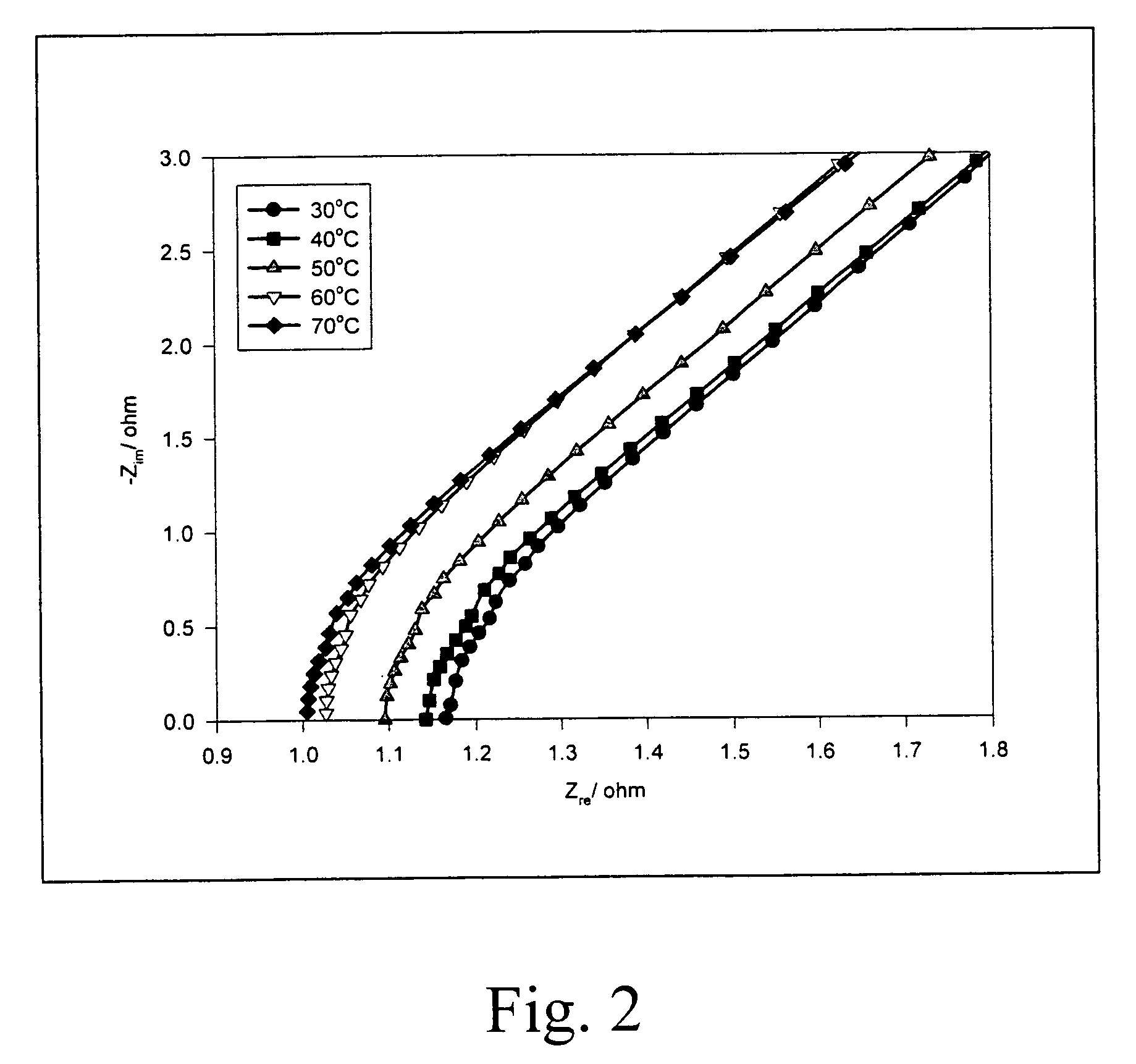Alkaline polymer electrolyte membrane and its application
a polymer electrolyte and polymer technology, applied in the field of alkaline polymer electrolyte membrane, can solve the problems of reducing the service life of the cell, and all existing techniques, etc., and achieves superior electrochemical stability, high mechanical strength, and ionic conductivity.
- Summary
- Abstract
- Description
- Claims
- Application Information
AI Technical Summary
Benefits of technology
Problems solved by technology
Method used
Image
Examples
example 1
[0038] Respectively based on the formula of specific proportions of PVA:PECH=1:1.0; PVA:PECH=1:1.5; or PVA:PECH=1:2.0, to precisely measure 5.0 g PVA and put it in a reactor containing 30 ml DMSO, and hold it in reaction for a period of 1 hour under a temperature of 60° C. until it is completely dissolved. Then put 5˜10 g PECH in another reactor containing 30 ml DMSO, and hold it in reaction for 1 hour under a temperature of 60° C. until it is completely dissolved, than pour the PECH solution into the reactor containing PVA solution.
[0039] Raise the reactor temperature to 50˜70° C., and hold the reaction continued for a time of 30 minutes. After finishing the reaction pour the glutinous liquid polymer into a culture dish with diameter of 10 cm, and control the weight of the polymer admixture poured into the dish about 5˜10 g, then put the dish in a thermostatic chamber with constant humidity of 5 RH % and temperature of 80° C. for a period about 12 hours.
[0040] Then take the cultu...
example 2
[0053] Choose one of the solid-state alkaline polymer electrolyte membrane made of the admixture of PVA and PECH of example 1 as test sample. Cut the membrane into size of 5 cm×5 cm, and soak the membrane in KOH aqueous solution of 32 wt %.
[0054] The variation of soaking time versus the amount of KOH aqueous solution contained in the polymer electrolyte membrane is shown in FIG. 4A. The effect of soaking time on the ionic conductivity of the polymer electrolyte membrane is shown in FIG. 4B.
[0055] From FIG. 4A, it shows that the solid-state alkaline electrolyte membrane with a PVA / PECH mixing ratio of 1:1 has the highest absorbability of KOH aqueous solution which can reach a rate of adsorption higher than 60% after 10 hours soaking, and the membrane with PAV / PECH mixing ration of 1:1.5 or 1:2 presents an adsorption around 40˜60 wt %.
[0056] From FIG. 4B, it also shows that when the solid-state alkaline electrolyte membrane made of admixture of PVA and PECH is soaked in KOH aqueous...
example 3
[0057] Measure 3 g zinc gel containing 60% zinc powder as the cathode, and use an air-electrode made of carbon powder as anode to construct a zinc-air cell, and choose one of the solid-state alkaline polymer membrane made of PVA / PECH admixture of example 1 as separator electrolyte, and installed the membrane between the zinc electrode and air electrode.
[0058] The whole assembly was installed in an acrylic case with size of 3 cm length by 2 cm width and area of 6 cm2 to form a zinc-air cell, and the electric discharge test were performed under different electric discharge speed, i.e. under different current of C / 5, C / 10 and C / 20. The test results are shown in Table 3 and Table 4.
TABLE 3Electric discharge characteristics of zinc-air cellinstalled with alkaline polymer electrolyte membranemade of the admixture of PVA and PECH of differentcomposition proportions under electric discharge speed of C / 10.Electrolyte of Composition ProportionTest itemPVA:PECH = 1:1PVA:PECH = 1:1.5Theoreti...
PUM
| Property | Measurement | Unit |
|---|---|---|
| Temperature | aaaaa | aaaaa |
| Temperature | aaaaa | aaaaa |
| Length | aaaaa | aaaaa |
Abstract
Description
Claims
Application Information
 Login to View More
Login to View More - R&D
- Intellectual Property
- Life Sciences
- Materials
- Tech Scout
- Unparalleled Data Quality
- Higher Quality Content
- 60% Fewer Hallucinations
Browse by: Latest US Patents, China's latest patents, Technical Efficacy Thesaurus, Application Domain, Technology Topic, Popular Technical Reports.
© 2025 PatSnap. All rights reserved.Legal|Privacy policy|Modern Slavery Act Transparency Statement|Sitemap|About US| Contact US: help@patsnap.com



